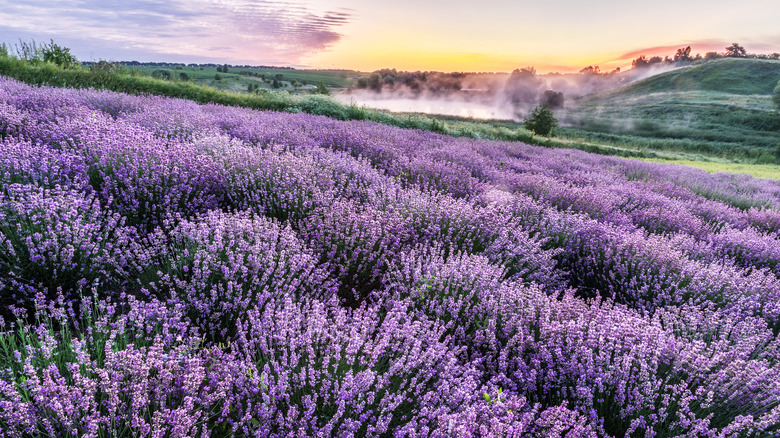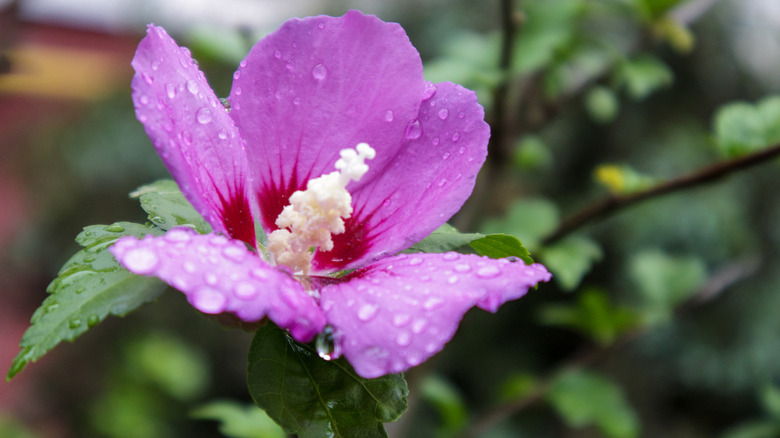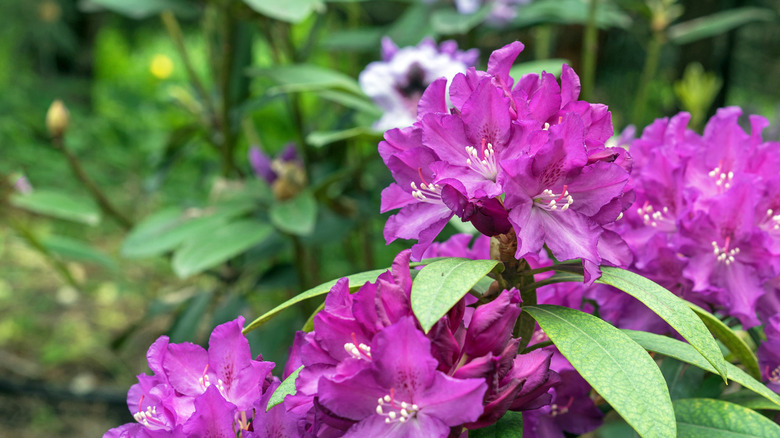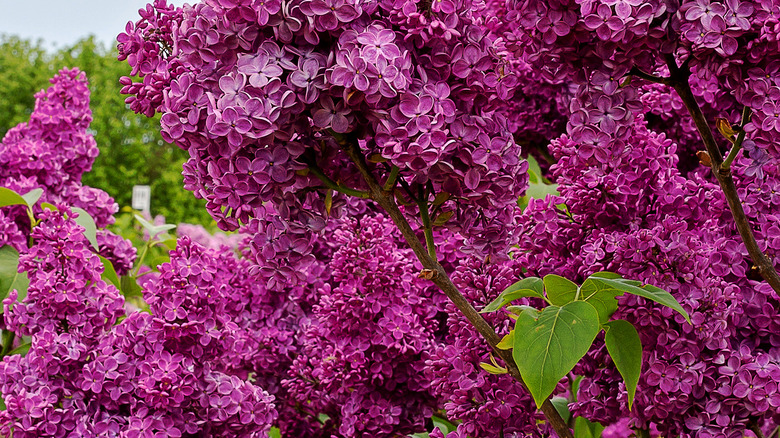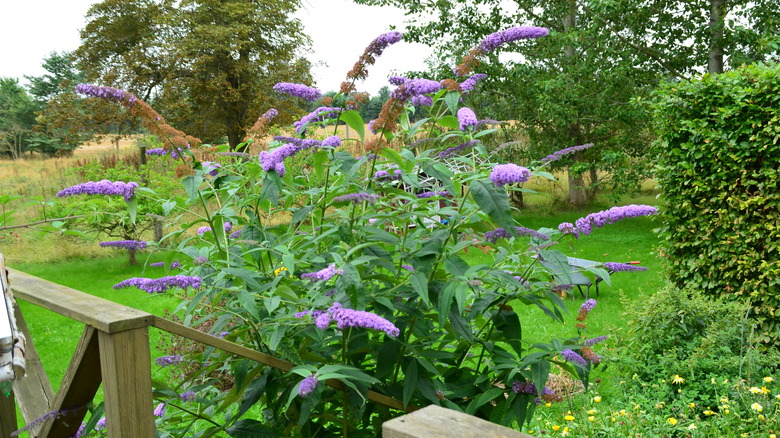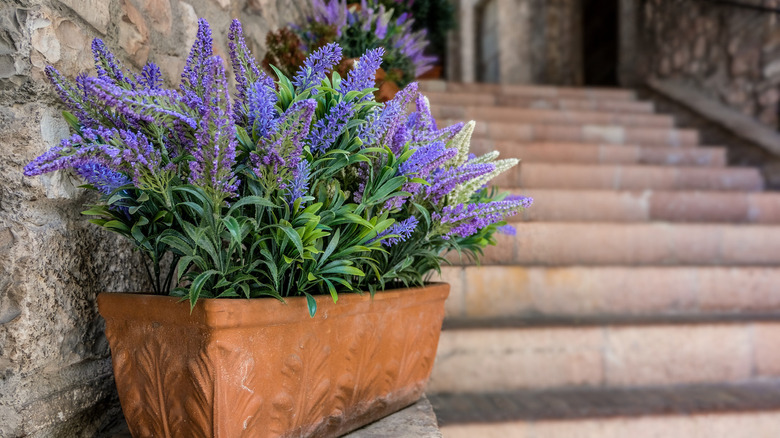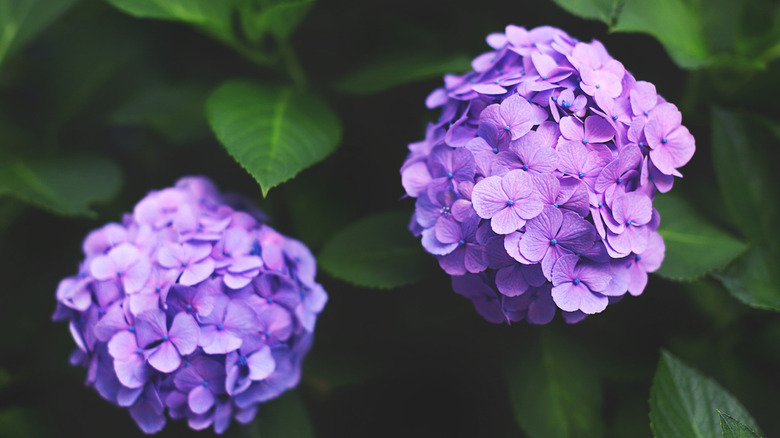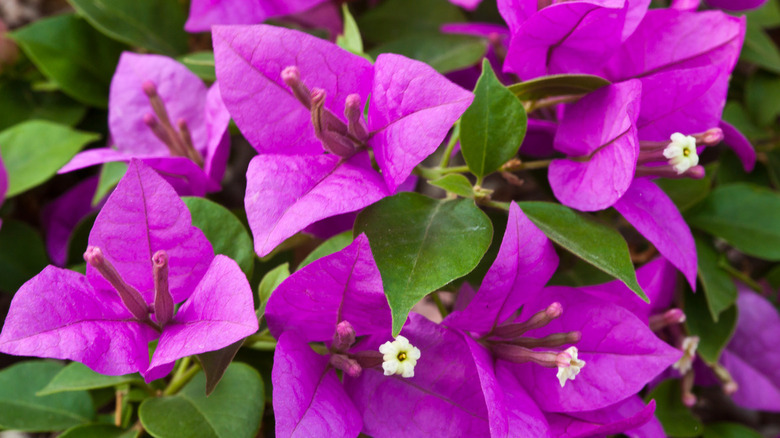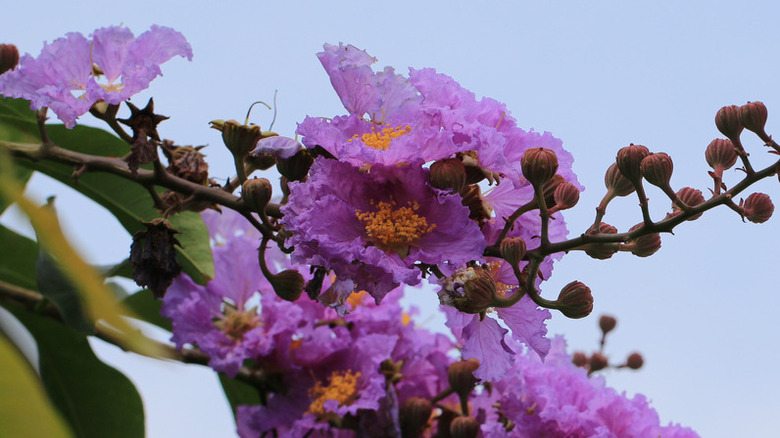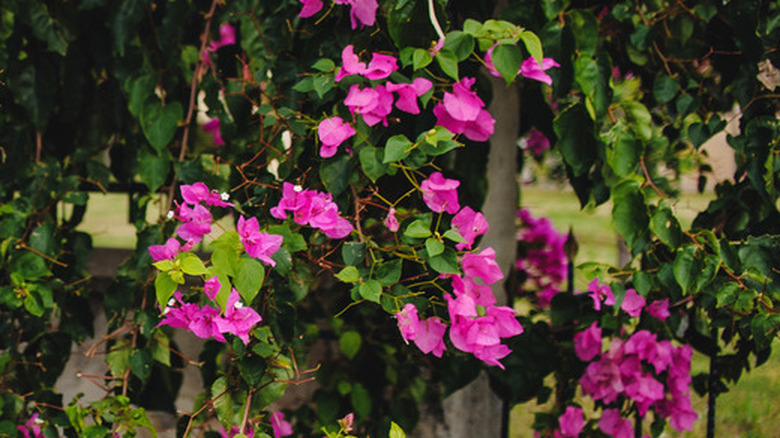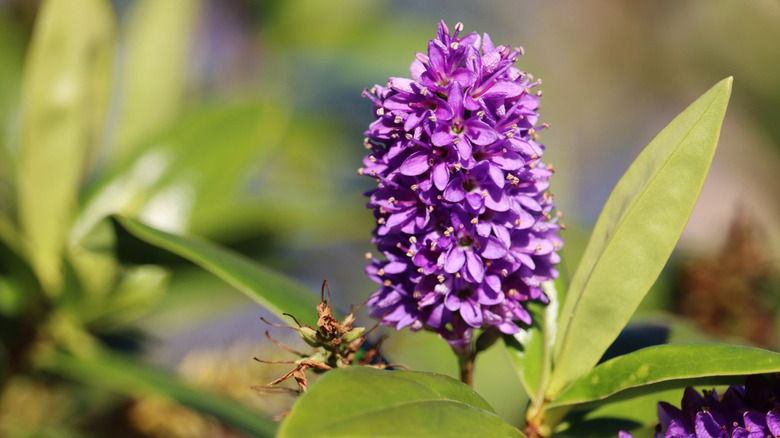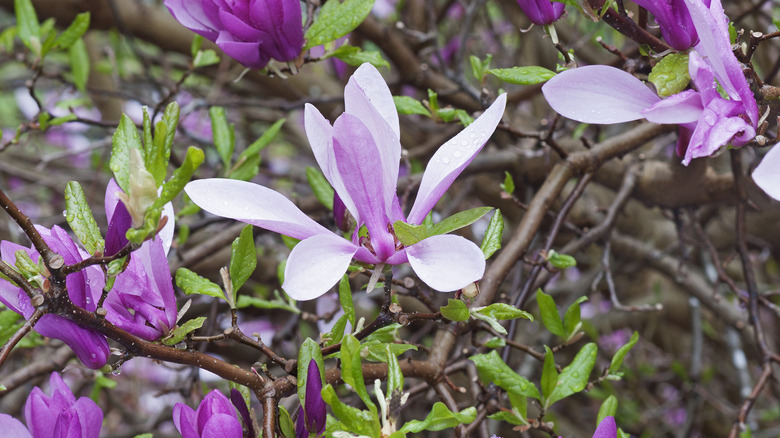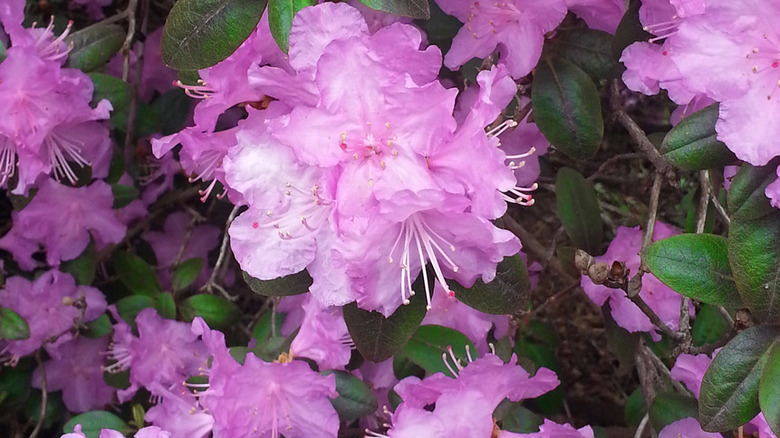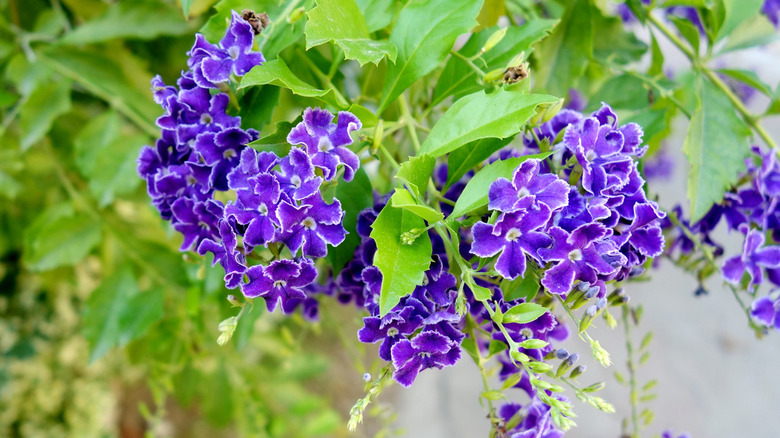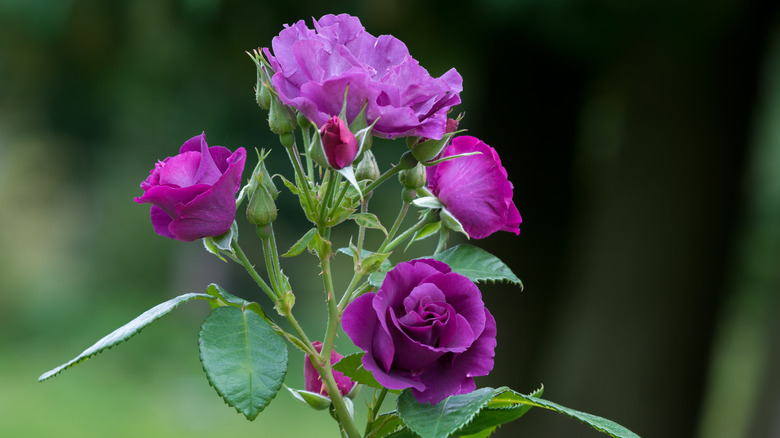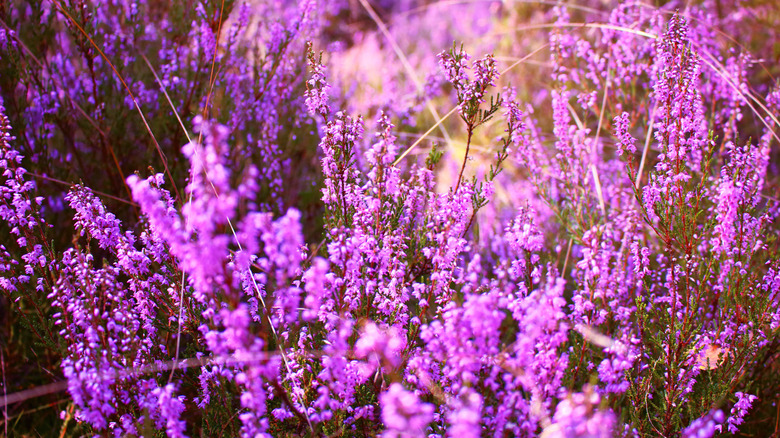15 Shrubs With Purple Flowers That Will Bring Color To Your Yard
There's something about purple; it's not only appealing to the eye but also associated with royalty and social class. So if you're looking for an opportunity to introduce some gorgeous purple flowers to your outdoor space, consider shrubs that produce purple flowers. Shrubs are significantly smaller than trees, making them ideal for anyone with a smaller yard or garden. What's more, there are plenty of shrub varieties to choose from.
But there are other reasons why you should consider planting shrubs other than beauty. The Local Enhancement & Appreciation of Forests (LEAF) mentions that some shrub varieties produce tasty fruits, provide privacy, and also encourage biodiversity by creating a habitat for some birds and insects.
There are several varieties of shrubs that bloom purple flowers in different seasons. Plenty of them are quite hardy and adapted to different climatic zones. No doubt the color purple will add depth and variety to your yard, so in a bid to help you pick the right one, here's a compilation of 15 beautiful shrub plants you can grow.
1. Rose of Sharon
The rose of Sharon (Hibiscus syriacus) is a shrub that can be trained into a tree if you prune the branches, leaving only the main trunk. This shrub is able to tolerate short bouts of drought and also wet soil during the rainy season. It blooms in a variety of colors but purple is the most common. The North Carolina Extension Gardener Plant Toolbox mentions that pruning during spring will help increase the flower size.
Bloom Season: June-October
USDA Growing Zone: 5 to 8
Growing Conditions: Full to partial sun exposure
Soil Type: Neutral organic soil
Size: 6 to 11 feet tall
2. Azaleas
The azalea (Rhododendron spp) is a popular shrub for all the right reasons. It's easy to care for and also blooms beautiful trumpet-shaped flowers. The azalea shrub is available in several varieties, including evergreens, deciduous, and native. Other than the common purple-colored flowers, this shrub also blooms in pink, white, red, and yellow (via the University of Florida Gardening Solutions).
Bloom Season: Early spring to summer
USDA Growing Zone: 6b to 8a
Growing Conditions: Full to partial sun exposure
Soil Type: Light well-drained soil
Size: 3 to 20 feet tall
3. Common lilac
The common lilac (Syringa vulgaris) is a deciduous hardy shrub popular for its scent. This plant blooms in flower clusters that may appear in different colors; for instance, purple, pink, white, or lavender, per Plants for a Future. Depending on the variety, the common lilac shrub can be quite inconsistent when it comes to flowering, but when it does, the purple flower clusters will light up your yard.
Bloom Season: Spring
USDA Growing Zone: 3 to 7
Growing Conditions: Full sun exposure
Soil Type: Neutral with medium moisture
Size: 12 to 16 feet tall
4. Butterfly bush
The butterfly bush (Buddleia davidii) is quite a versatile shrub, depending on the specific climatic condition. In warmer conditions, it's a deciduous shrub with impressive purple flowers, while in colder climates, the butterfly bush is a perennial plant that dies back during winter. While it's a beautiful addition to any yard or garden, the University of Maryland Extension explains the butterfly bush is an invasive species whose growth needs to be controlled.
Bloom Season: Summer
USDA Growing Zone: 5 to 9
Growing Conditions: Full sun exposure
Soil Type: Acidic well-drained soil
Size: 3 to 12 feet tall
5. Lavender
The lavender (Lavendula) plant is another perennial shrub that blooms with beautiful purple flowers. There are plenty of varieties of the lavender shrub but the English and French lavender are the most popular. The UIC Heritage Garden notes that this shrub can tolerate most conditions, including drought, making it a nice consideration for xeriscaping.
Bloom Season: Midsummer
USDA Growing Zone: 5 to 8
Growing Conditions: Full sun exposure
Soil Type: Well-drained soil
Size: 1 to 3 feet tall
6. Hydrangea
Hydrangea (Hydrangea macrophylla), also known as bigleaf hydrangea, is common among gardening communities thanks to the plump flowerheads of this shrub. According to Mandy Bayer from the University of Massachusetts Amherst, this plant won't bloom in its first season as it's still in the establishment phase. While it may have some specific maintenance needs, the colorful blooms of the hydrangea will be worth all the trouble.
Bloom Season: Summer
USDA Growing Zone: 6 to 9
Growing Conditions: Full sun exposure
Soil Type: Well-drained acidic soil
Size: 4 to 5 feet tall
7. Bougainvillea
The bougainvillea (genus Bougainvillea) is a climbing shrub that loves the sun and blooms in a variety of colors, depending on the specific bougainvillea species. As a climbing plant, bougainvillea can grow long and not have the usual rounded shrub-like appearance; however, per the North Carolina Extension Gardener Plant Toolbox, you can train this plant to grow as a shrub in containers. It's a fast grower and can add up to 36 inches every year.
Bloom Season: Spring, summer, fall
USDA Growing Zone: 9 to11
Growing Conditions: Full sun exposure
Soil Type: Well-drained acidic soil
Size: 15 to 40 feet tall
8. Crapemyrtle
If you're looking for a shrub that can also serve as a small tree, then the crapemyrtle (Lagerstroemia indica) might be ideal for you. Out in the wild, this small tree blooms with pink flowers; however, cultivated varieties produce white, mauve, and purple flowers. The Arbor Day Foundation explains that pruning new growth, especially during the early development stages, will help increase the number of stems and flowers.
Bloom Season: Spring to summer
USDA Growing Zone: 6 to 9
Growing Conditions: Full sun exposure
Soil Type: Moist well-drained
Size: 15 to 25 feet tall
9. Weigela
Weigela florida is an old-fashioned shrub that's still a favorite among gardening enthusiasts today. This shrub grows at a fairly moderate pace, adding about 13 inches yearly. Despite this slow growth, pruning is necessary to help control the growth and shape, per the North Carolina Extension Gardener Plant Toolbox. Other than purple, weigela also blooms in white, pink, and yellow, depending on the variety.
Bloom Season: Spring to early summer
USDA Growing Zone: 6 to 9
Growing Conditions: Full sun exposure
Soil Type: Moist well-drained
Size: 6 to 10 feet tall
10. Hebe
The hebe shrub (Hebe spp) is among the easiest plants to cultivate; they can tolerate both mild summers and winters perfectly. You will also love the colorful leaves and showy blooms this shrub produces during the summer or fall. The hebe shrub also produces white, blue, pink, and red flowers. You'll need to prune this shrub right after flowering to maintain the bushy appearance (via the University of California Agriculture and Natural Resources).
Bloom Season: Summer to fall
USDA Growing Zone: 7 to 11
Growing Conditions: Full sun exposure
Soil Type: Acidic well-drained
Size: 1 to 6 feet
11. Ann magnolia
This particular variety of magnolia shrub is called "Ann." This hybrid deciduous shrub is popular for its showy reddish-purple blooms. One unique characteristic of this shrub is that it blooms early in the stage of development, way before the leaves emerge, making it the perfect specimen plant. Keep in mind that the Ann magnolia needs some pruning to keep the shape and control growth (via the Missouri Botanical Garden).
Bloom Season: April to May
USDA Growing Zone: 4 to 8
Growing Conditions: Full sun to part shade
Soil Type: well-drained
Size: 8 to 10 feet
12. Rhododendron 'P.J.M.'
The rhododendron 'P.J.M.' (genus Rhododendron) variety is an extremely cold hardy shrub that's quite popular in North America. Unlike the other varieties, the P.J.M type has vigorous foliage and showy lavender-pink flowers. The green foliage also turns reddish-purple during the fall and winter seasons (via The Morton Arboretum). It grows in dense rounded shapes, which look lovely in any yard.
Bloom Season: April
USDA Growing Zone: 4 to 7
Growing Conditions: Partial exposure
Soil Type: Moist acidic well-drained
Size: 3 to 7 feet
13. Golden dewdrop
Golden dewdrop (Duranta erecta) is common in the tropical U.S., especially in sunny regions, according to the University of Florida Extension. While the golden dewdrop is golden, the flowers are blue to violet and the leaves are as green as they come. However, it's worth mentioning that the yellow fruit that comes after the bloom is poisonous to human beings.
Bloom Season: Summer and fall
USDA Growing Zone: 8 to 11
Growing Conditions: Full sun exposure
Soil Type: Moist acidic/alkaline well-drained soil
Size: 2 to 18 feet
14. Rose
What other garden shrub is coveted more than the rose (Rosa spp)? While it might need relatively more care and maintenance than the average shrub, growing roses in your yard is worth all the hard work. Purple roses are not natural; however, Jackson & Perkins notes that the hybrid tea rose is available in a plethora of colors, including purple.
Bloom Season: Spring to fall
USDA Growing Zone: 4 to 10
Growing Conditions: Full sun exposure
Soil Type: Neutral well-drained loamy soil
Size: Up to 20 feet
15. Heather
Heather (Calluna vulgaris) is a low-growing shrub that is known for its long-lasting blooms. While it's popular for its purple flowers, this shrub also produces other shades, including red, white, orange, and pink. While this plant thrives in cool climates, it should be grown under the sun, especially in colder regions. For the hot regions, this shrub should be grown in partial shade, per the Missouri Botanical Garden.
Bloom Season: July to September
USDA Growing Zone: 4 to 6
Growing Conditions: Full sun to part shade
Soil Type: Acidic sandy soil
Size: Up to 2 feet tall
